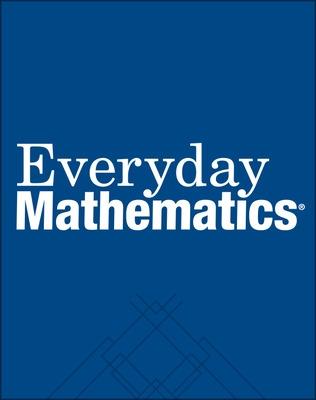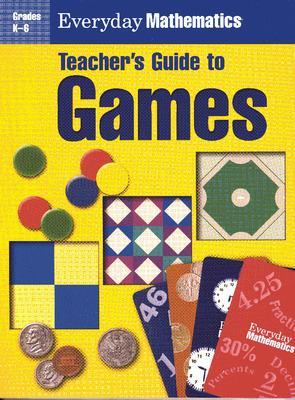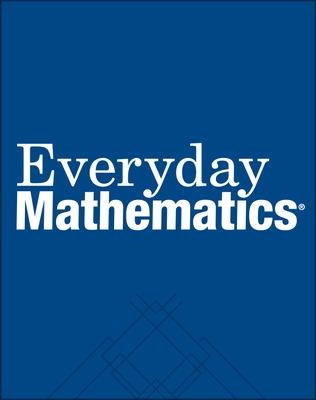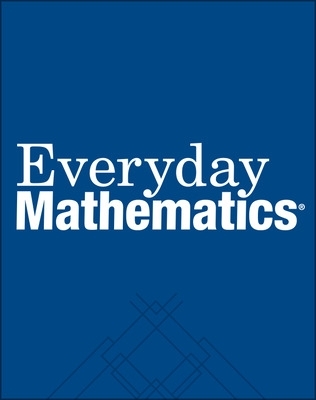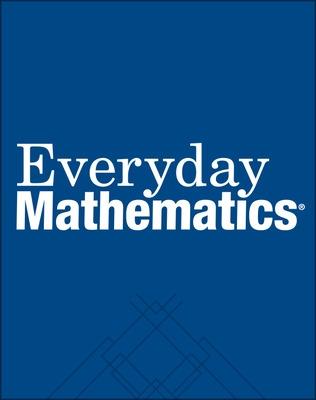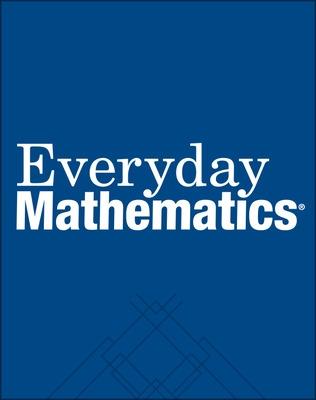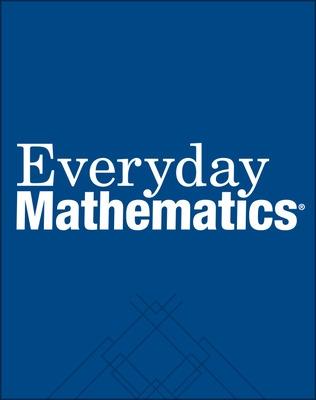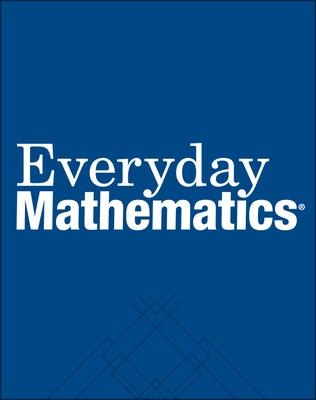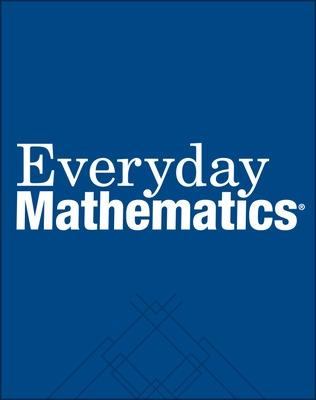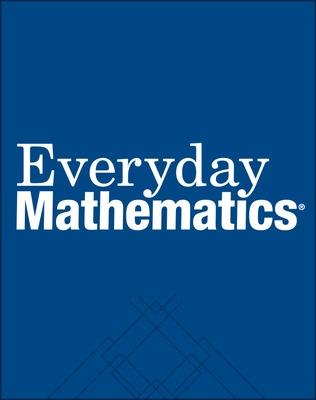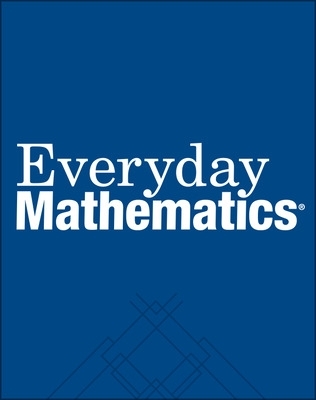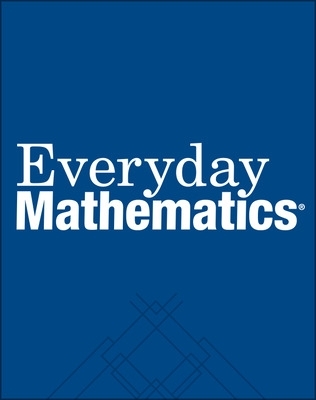EVERYDAY MATH GAMES KIT
21 total works
Everyday Mathematics, Grades K-6, Games Kit Components, Teacher's Guide
by McGraw Hill
Everyday Mathematics, Grades PK-3, Play Money Coin Set (Set of 88)
by McGraw Hill
Everyday Mathematics, Grades 4-6 Family Games Kit Fraction/Decimal/Percent Card Deck (Set of 5)
by McGraw Hill
These cards show 18 different fractions, decimals, and percents. The fractions, decimals, and percents are equivalent to each other. The cards teach alternative ways of expressing quotients. Activities using the Fraction/Decimal/Percent Card Deck include:
- Comparing and ordering fractions
- Comparing and ordering decimals
- Comparing and ordering percents
- Comparing and ordering fractions, decimals, and/or percents
Everyday Mathematics, Grades 1-6, Family Games Kit Everything Math Deck (Set of 5)
by McGraw Hill
Everyday Mathematic Grades PK-K, Family Games Kit Number Card Deck (Set of 5)
by McGraw Hill
This deck contains four cards each of the numbers 0 though 10 and one card each for the numbers 11-20. Activities using the Number Card Deck include:
- Reading numbers
- Writing numbers
- Ordering numbers
- Using concrete objects to represent the number on a card
Everyday Mathematics Grades 1-3, Family Games Kit Money Card Deck (Set of 5)
by McGraw Hill
Money cards show pictures of various combinations of pennies, nickels, dimes, and quarters. Activities using the Money Card Deck include:
- Showing money amounts
- Finding and comparing the values of coin contributions
- Writing money amounts using dollar-and-cents notation
Everyday Mathematics, Grades 1-3, Family Games Kit Time Card Deck (Set of 5)
by McGraw Hill
Shows digital and analog clock times as well as times expressed in words. Activities using the Time Card Deck include:
- Calculating elapsed time
- Solving number stories involving time
- Identifying times for students' daily activities
Everyday Mathematics 2012, Classroom Games Kit, Grade 6
Everyday Mathematics® enables students to build conceptual understanding, computational fluency, and real-world problem-solving skills. The University of Chicago School Mathematics Project continues to develop Everyday Mathematics® to enable students to become strong mathematical citizens for the 21st century.
Everyday Mathematics is a core curriculum for students in pre-kindergarten through sixth grade. At each grade level students are provided opportunities to learn concepts and practice skills in a variety of representations. A concept like fractions may first be introduced using a concrete representation such as base-ten blocks. Next the student may be asked to draw a pictorial representation of a fraction. A story problem may be introduced and finally an abstract representation of the fraction is introduced to the student. Using multiple representations of concepts helps students understand how abstract or formulaic representations of math are connected to the physical world.
Everyday Mathematics' focus on real-life problem solving forces students to see how math touches their lives every day. Students are given the freedom to explore different ways of solving problems and taught how to communicate their mathematical thinking. These are recognized strengths of the Everyday Mathematics program and are a large part of the Common Core State Standards. In particular, the Standards of Mathematical Practice are covered extensively in Everyday Mathematics and have been at the heart of the program for the last 25 years when NCTM released a precursor to the Practice Standards called the Process Standards.
The authors of Everyday Mathematics painstakingly reviewed the Common Core State Standards and realigned content to match expectations in the Common Core. However, the authors have remained true to the pedagogy and their mission of making all students lifelong mathematical thinkers.
Everyday Mathematics 2012, Interactive Wallchart, Grade 5
Everyday Mathematics® enables students to build conceptual understanding, computational fluency, and real-world problem-solving skills. The University of Chicago School Mathematics Project continues to develop Everyday Mathematics® to enable students to become strong mathematical citizens for the 21st century.
Everyday Mathematics is a core curriculum for students in pre-kindergarten through sixth grade. At each grade level students are provided opportunities to learn concepts and practice skills in a variety of representations. A concept like fractions may first be introduced using a concrete representation such as base-ten blocks. Next the student may be asked to draw a pictorial representation of a fraction. A story problem may be introduced and finally an abstract representation of the fraction is introduced to the student. Using multiple representations of concepts helps students understand how abstract or formulaic representations of math are connected to the physical world.
Everyday Mathematics' focus on real-life problem solving forces students to see how math touches their lives every day. Students are given the freedom to explore different ways of solving problems and taught how to communicate their mathematical thinking. These are recognized strengths of the Everyday Mathematics program and are a large part of the Common Core State Standards. In particular, the Standards of Mathematical Practice are covered extensively in Everyday Mathematics and have been at the heart of the program for the last 25 years when NCTM released a precursor to the Practice Standards called the Process Standards.
The authors of Everyday Mathematics painstakingly reviewed the Common Core State Standards and realigned content to match expectations in the Common Core. However, the authors have remained true to the pedagogy and their mission of making all students lifelong mathematical thinkers.
Everyday Mathematics, Grades PK-K, Inch Cubes - Wood (Package of 10)
by McGraw Hill
Everyday Mathematics 2012, Interactive Wallchart, Grade 3
Everyday Mathematics® enables students to build conceptual understanding, computational fluency, and real-world problem-solving skills. The University of Chicago School Mathematics Project continues to develop Everyday Mathematics® to enable students to become strong mathematical citizens for the 21st century.
Everyday Mathematics is a core curriculum for students in pre-kindergarten through sixth grade. At each grade level students are provided opportunities to learn concepts and practice skills in a variety of representations. A concept like fractions may first be introduced using a concrete representation such as base-ten blocks. Next the student may be asked to draw a pictorial representation of a fraction. A story problem may be introduced and finally an abstract representation of the fraction is introduced to the student. Using multiple representations of concepts helps students understand how abstract or formulaic representations of math are connected to the physical world.
Everyday Mathematics' focus on real-life problem solving forces students to see how math touches their lives every day. Students are given the freedom to explore different ways of solving problems and taught how to communicate their mathematical thinking. These are recognized strengths of the Everyday Mathematics program and are a large part of the Common Core State Standards. In particular, the Standards of Mathematical Practice are covered extensively in Everyday Mathematics and have been at the heart of the program for the last 25 years when NCTM released a precursor to the Practice Standards called the Process Standards.
The authors of Everyday Mathematics painstakingly reviewed the Common Core State Standards and realigned content to match expectations in the Common Core. However, the authors have remained true to the pedagogy and their mission of making all students lifelong mathematical thinkers.
Everyday Mathematics 2012, Classroom Games Kit, Grade 3
Everyday Mathematics® enables students to build conceptual understanding, computational fluency, and real-world problem-solving skills. The University of Chicago School Mathematics Project continues to develop Everyday Mathematics® to enable students to become strong mathematical citizens for the 21st century.
Everyday Mathematics is a core curriculum for students in pre-kindergarten through sixth grade. At each grade level students are provided opportunities to learn concepts and practice skills in a variety of representations. A concept like fractions may first be introduced using a concrete representation such as base-ten blocks. Next the student may be asked to draw a pictorial representation of a fraction. A story problem may be introduced and finally an abstract representation of the fraction is introduced to the student. Using multiple representations of concepts helps students understand how abstract or formulaic representations of math are connected to the physical world.
Everyday Mathematics' focus on real-life problem solving forces students to see how math touches their lives every day. Students are given the freedom to explore different ways of solving problems and taught how to communicate their mathematical thinking. These are recognized strengths of the Everyday Mathematics program and are a large part of the Common Core State Standards. In particular, the Standards of Mathematical Practice are covered extensively in Everyday Mathematics and have been at the heart of the program for the last 25 years when NCTM released a precursor to the Practice Standards called the Process Standards.
The authors of Everyday Mathematics painstakingly reviewed the Common Core State Standards and realigned content to match expectations in the Common Core. However, the authors have remained true to the pedagogy and their mission of making all students lifelong mathematical thinkers.
Everyday Mathematics 2012, Interactive Wallchart, Grade 2
Everyday Mathematics® enables students to build conceptual understanding, computational fluency, and real-world problem-solving skills. The University of Chicago School Mathematics Project continues to develop Everyday Mathematics® to enable students to become strong mathematical citizens for the 21st century.
Everyday Mathematics is a core curriculum for students in pre-kindergarten through sixth grade. At each grade level students are provided opportunities to learn concepts and practice skills in a variety of representations. A concept like fractions may first be introduced using a concrete representation such as base-ten blocks. Next the student may be asked to draw a pictorial representation of a fraction. A story problem may be introduced and finally an abstract representation of the fraction is introduced to the student. Using multiple representations of concepts helps students understand how abstract or formulaic representations of math are connected to the physical world.
Everyday Mathematics' focus on real-life problem solving forces students to see how math touches their lives every day. Students are given the freedom to explore different ways of solving problems and taught how to communicate their mathematical thinking. These are recognized strengths of the Everyday Mathematics program and are a large part of the Common Core State Standards. In particular, the Standards of Mathematical Practice are covered extensively in Everyday Mathematics and have been at the heart of the program for the last 25 years when NCTM released a precursor to the Practice Standards called the Process Standards.
The authors of Everyday Mathematics painstakingly reviewed the Common Core State Standards and realigned content to match expectations in the Common Core. However, the authors have remained true to the pedagogy and their mission of making all students lifelong mathematical thinkers.
Everyday Mathematics 2012, Classroom Games Kit, Grade 2
Everyday Mathematics® enables students to build conceptual understanding, computational fluency, and real-world problem-solving skills. The University of Chicago School Mathematics Project continues to develop Everyday Mathematics® to enable students to become strong mathematical citizens for the 21st century.
Everyday Mathematics is a core curriculum for students in pre-kindergarten through sixth grade. At each grade level students are provided opportunities to learn concepts and practice skills in a variety of representations. A concept like fractions may first be introduced using a concrete representation such as base-ten blocks. Next the student may be asked to draw a pictorial representation of a fraction. A story problem may be introduced and finally an abstract representation of the fraction is introduced to the student. Using multiple representations of concepts helps students understand how abstract or formulaic representations of math are connected to the physical world.
Everyday Mathematics' focus on real-life problem solving forces students to see how math touches their lives every day. Students are given the freedom to explore different ways of solving problems and taught how to communicate their mathematical thinking. These are recognized strengths of the Everyday Mathematics program and are a large part of the Common Core State Standards. In particular, the Standards of Mathematical Practice are covered extensively in Everyday Mathematics and have been at the heart of the program for the last 25 years when NCTM released a precursor to the Practice Standards called the Process Standards.
The authors of Everyday Mathematics painstakingly reviewed the Common Core State Standards and realigned content to match expectations in the Common Core. However, the authors have remained true to the pedagogy and their mission of making all students lifelong mathematical thinkers.
Everyday Mathematics 2012, Classroom Games Kit, Grade 1
Everyday Mathematics® enables students to build conceptual understanding, computational fluency, and real-world problem-solving skills. The University of Chicago School Mathematics Project continues to develop Everyday Mathematics® to enable students to become strong mathematical citizens for the 21st century.
Everyday Mathematics is a core curriculum for students in pre-kindergarten through sixth grade. At each grade level students are provided opportunities to learn concepts and practice skills in a variety of representations. A concept like fractions may first be introduced using a concrete representation such as base-ten blocks. Next the student may be asked to draw a pictorial representation of a fraction. A story problem may be introduced and finally an abstract representation of the fraction is introduced to the student. Using multiple representations of concepts helps students understand how abstract or formulaic representations of math are connected to the physical world.
Everyday Mathematics' focus on real-life problem solving forces students to see how math touches their lives every day. Students are given the freedom to explore different ways of solving problems and taught how to communicate their mathematical thinking. These are recognized strengths of the Everyday Mathematics program and are a large part of the Common Core State Standards. In particular, the Standards of Mathematical Practice are covered extensively in Everyday Mathematics and have been at the heart of the program for the last 25 years when NCTM released a precursor to the Practice Standards called the Process Standards.
The authors of Everyday Mathematics painstakingly reviewed the Common Core State Standards and realigned content to match expectations in the Common Core. However, the authors have remained true to the pedagogy and their mission of making all students lifelong mathematical thinkers.
